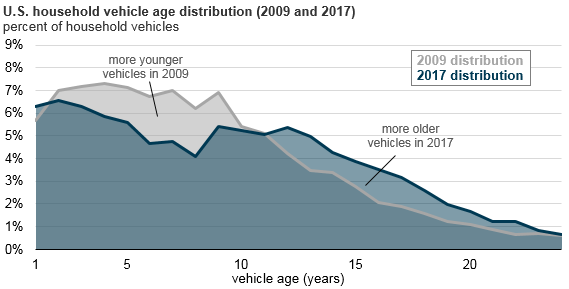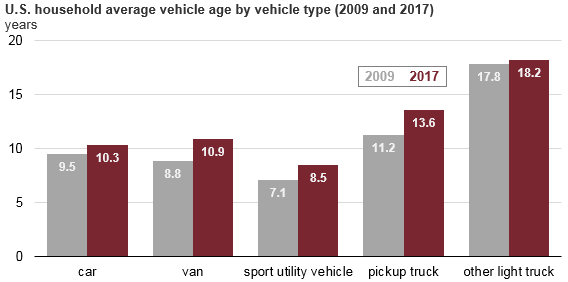The U.S. Department of Transportation conducted a survey that has been released by the U.S. Energy Information Administration (EIA) that concludes households are holding onto vehicles longer in 2017 compared to 2009.
[avatar user=”croberts” size=”thumbnail” align=”left” /]
Continuing our conversation on the volume use and of older vehicles on U.S. roadways, an interesting report was recently released by the United States Energy Information Administration (EIA). Based upon a survey conducted by the U.S. Department of Transportation, the report finds that the turnover of vehicles in U.S. households in 2017 has slowed since 2009.
The 2017 National Household Survey further found that the average age of vehicles in service in all light duty vehicle categories, grew from 9.5 years in 2009 to 10.3 years in 2017.
As the report contends, this aging of vehicles on the American roadway can present significant environmental implications as newer vehicles tend to have better fuel economies and older, poorly maintained vehicles emit a far greater percentage of pollutants into the atmosphere. A 2015 study by researchers at the University of Toronto found that 25% of the cars on Canadian roadways were responsible for 90% of the vehicle fleet pollution.
Not surprisingly, households with lower incomes tended to have a higher percentage of older vehicles. However, the report suggests that that gap is narrowing. The average age of vehicles used by higher income households grew at a higher percentage rate than those in lower income. The reports’ principal contributor Mark Schipper, further suggests that US households have delayed purchasing a new vehicle OR are choosing to purchase a pre-owned vehicle instead. A recent report from the US Bureau of Labor Statistics does support the finding that US consumers’ spending on vehicle maintenance and repairs have increased in recent years.
Where to find more Wreckonomics content
Stay in the Wreckonomics conversation for more content surrounding the auto industry, the growing segment of vehicles in operation, auto recycling data and news surrounding materials used in auto manufacturing. Follow the Market & Metals blog by signing up for email alerts below or follow along on Facebook, Twitter or LinkedIn.



